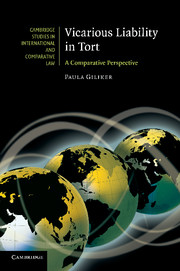Book contents
- Frontmatter
- Contents
- Diagrams
- Table of cases
- Table of legislation
- Preface
- 1 What is vicarious liability?
- 2 Establishing a general framework for liability
- 3 The employer/employee relationship: identifying the contract of employment
- 4 Special difficulties: borrowed employees and temporary workers
- 5 Other relationships giving rise to liability
- 6 Acting in the course of one's employment/functions/assigned tasks: determining the scope of vicarious liability
- 7 Parental liability for the torts of their children: a new form of vicarious liability?
- 8 Understanding vicarious liability: reconciling policy and principle
- 9 A postscript: a harmonised European law of vicarious liability?
- Appendix: Key provisions of the French and German Civil Codes
- Index
- Titles in the series
5 - Other relationships giving rise to liability
Published online by Cambridge University Press: 10 November 2010
- Frontmatter
- Contents
- Diagrams
- Table of cases
- Table of legislation
- Preface
- 1 What is vicarious liability?
- 2 Establishing a general framework for liability
- 3 The employer/employee relationship: identifying the contract of employment
- 4 Special difficulties: borrowed employees and temporary workers
- 5 Other relationships giving rise to liability
- 6 Acting in the course of one's employment/functions/assigned tasks: determining the scope of vicarious liability
- 7 Parental liability for the torts of their children: a new form of vicarious liability?
- 8 Understanding vicarious liability: reconciling policy and principle
- 9 A postscript: a harmonised European law of vicarious liability?
- Appendix: Key provisions of the French and German Civil Codes
- Index
- Titles in the series
Summary
Introduction
The employer/employee relationship represents the most common example of a relationship giving rise to vicarious liability in tort. Nevertheless, the key characteristics of one person acting ostensibly in the interests of another with the latter being held responsible for the former's tortious actions may be identified in other relationships. As will be seen, there is case law authority in both common and civil law jurisdictions that vicarious liability extends beyond the employer/employee relationship. Legislation may additionally, for specific policy reasons, designate a relationship as giving rise to vicarious liability.
This chapter will seek to define the boundaries of the relationships giving rise to vicarious liability in tort. In civilian systems, extending liability beyond the employer/employee relationship raises no great conceptual difficulties. Use of the broader terms of ‘commettant/préposé’ and ‘Geschäftsherr/Verrichtungsgehilfe’ under Article 1384(5) of the French Civil Code or § 831 of the German Civil Code, signifies that the courts, if it is considered appropriate, may apply the codal provisions to any relationships capable of meeting the tests of subordination or the right to give instructions. In contrast, the common law requirement of a contract of employment (or contract of service) has rendered extensions of the doctrine to other analogous relationships problematic. This has not, however, prevented an extension of strict liability beyond the employment relationship. As we will see, a variety of techniques are utilised. In common with civil law, specific legislation has served to include relationships where the application of the principle of vicarious liability is considered desirable.
- Type
- Chapter
- Information
- Vicarious Liability in TortA Comparative Perspective, pp. 101 - 144Publisher: Cambridge University PressPrint publication year: 2010
- 1
- Cited by

